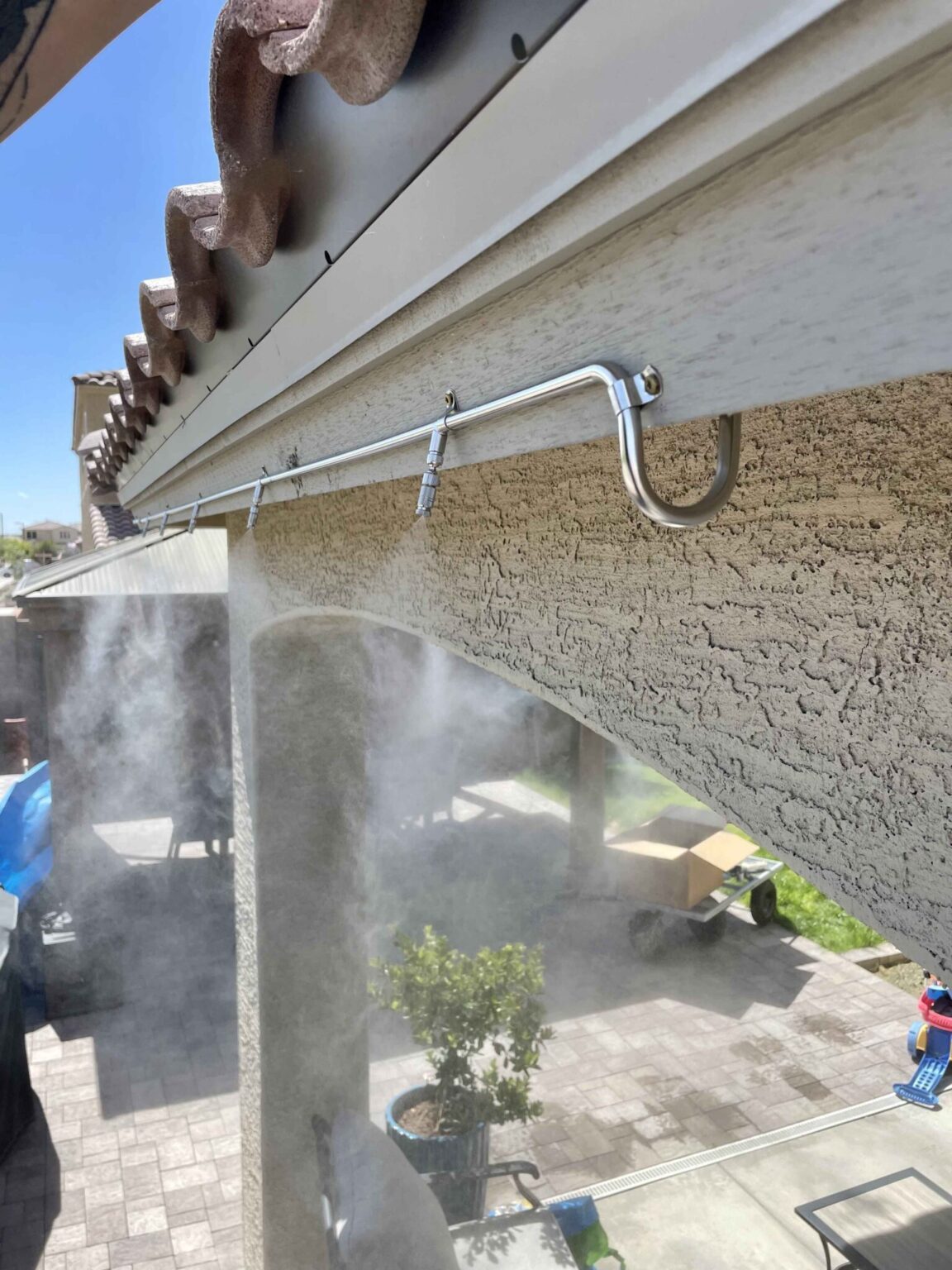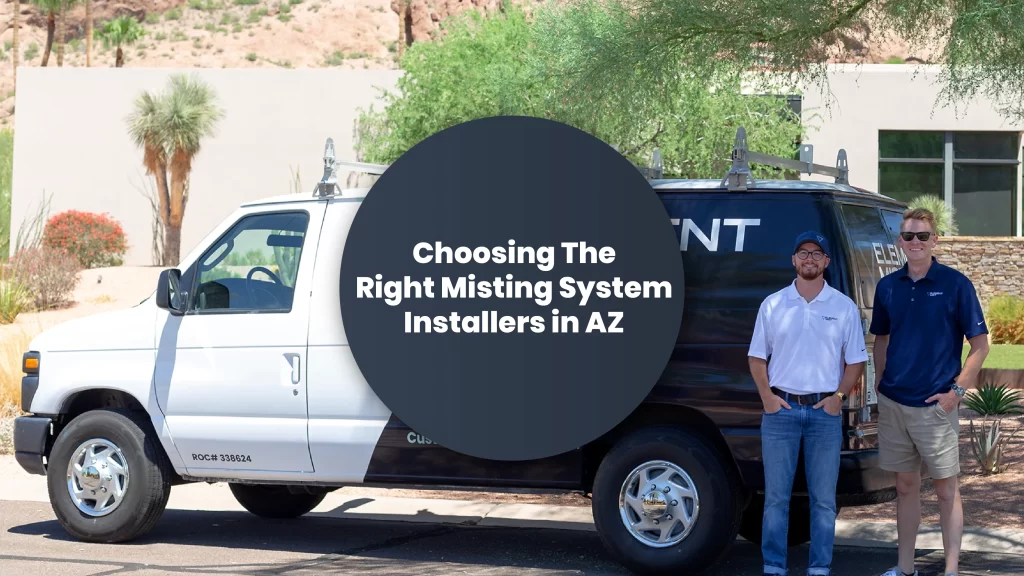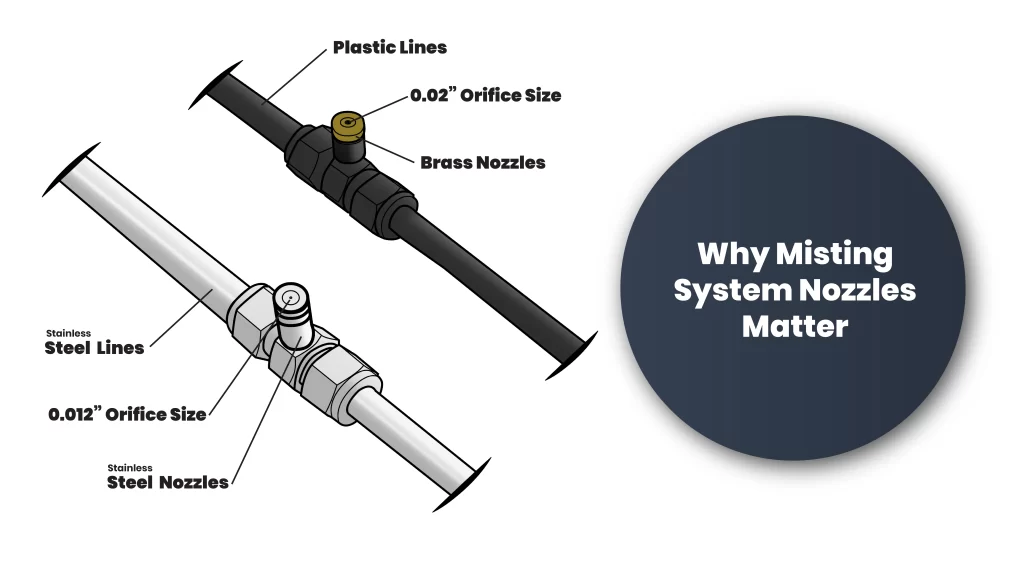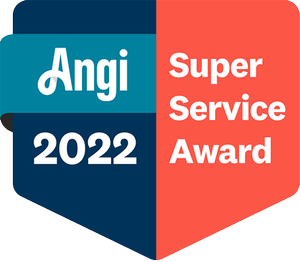Overview
High quality misting systems, like those installed by Element Mist, utilize small-apatured nozzles and high pressure to achieve a fine mist, which, evaporating rapidly, cools the surrounding air. Element Mists high-pressure systems utilize extremely durable and highly calibrated Cat pumps to build pressure up to 1,000 psi, compared to the relatively low (45-80 psi) pressure fed by the city to the standard residential or commercial buildings water pipes. This extra pressure equates to more power, and subsequently, the ability to attomize the mist into an extremely fine droplet size (measured in microns). The finer the droplet size of the mist, the more effective the evaporative cooling will be. As a result, this finer mist can not only evaporate quicker, but will also keep the surrounding surfaces, windows, and walkways dry. A well designed system can effectively cool the air by around 25 degrees or more, and can be enjoyed without getting you and your surroundings wet.
Design
Believe it or not, high-pressure misting systems aren’t quite as easy as plug and play. Many “misting systems” sold online or in larger retail stores lack the components necessary to create a clean, cooling effect. One can expect to essentially lose their investment after short use with an over-the-counter system, as they do not come with sufficient pressurization, filtration, machined components, and more importantly a warranty! What’s more, these “systems” lack the thoughtfulness and intentionality that is required to design a misting system which will effectively cool a specified area during a specified time of the year. More doesn’t always equal better, and this is especially true when it comes to misting. Restaurants are notorious for running a misting system which does better to dampen your food than it does to effectively cool the air around you. Avoiding the extremes in misting all comes down to design. At Element Mist we start with YOUR needs and goals. From there we work in tandem with you to ensure that the system we design is best catered to the time of year, and amount of space you need to cool.
Misting Pumps
The key component that Element Mist employs to achieve cooling mist is the pump that powers the system. Our pumps do this by increasing the normal city water pressure of about 70 psi to at least 1000 psi. There are several different types of pumps but choosing the right one for the job will come down to flow rate which is measured in gallons per minute (often shortened to “gpm”). High-pressure misting pumps are chosen by our team based on the specific amount of nozzles and nozzle aperture sizes, to ensure that the precise amount of water is being delivered through the system for maximum efficiency, as well as maximum effectiveness. Pumps can come in many configurations, which range from all stainless steel, multi-zone rigs which can handle RO water and multiple areas independently (recommended for grow facilities or the homeowner who simply demands the best) or more simple cast pumps which can run a small patio with ease. Pumps can come either encased in a sounds-deadening enclosure for long term weather protection, or open to the elements (best for a pump which can be hidden away in a shed or storage space). Element Mist also offers a low-pressure shut off upgrade which will protect the pump in the event the water supply is accidentally cut off to the pump. Element Mist also locates the system filtration at the pumps which we will get into next. Please refer to our packages for more information regarding pump upgrades as they relate to our offerings.
Filtration
In considering pump specifications we will naturally need to touch upon water filtration. Not only will adequate filtration prolong the life of the pump itself, but more importantly will keep debris out of your piping and nozzles. The nozzles are highly calibrated and have very small openings, or apertures, that Element Mist will work to prevent from being clogged by providing top-tier filtration along with regular servicing to the overall system. The most common filter used is a sediment filter – this is exactly what it sounds like, filtering out any particles in the feed water typically up to 5 microns in size depending on the type of filter. Another common filter upgrade is a scale inhibitor filter which does exactly what it says, it helps to reduce the effects of scale from hard water. Element Mist has included several filtration upgrades for you to choose from when considering which package level will work for you. These are very effective in reducing the negative effects of scale forming on the nozzles which will reduce the effectiveness of your system over time, though this does not negate the need for regular servicing to the system.
Nozzles
Nozzles are the business end of a properly operating system, finely atomizing the water to create the desired mist. Nozzles come in several different shapes, sizes, materials, and most importantly, orifice size. The orifice size of the nozzle can be thought of similarly to the aperture of a camera lens; it is simply how large or small the hole is that the water will pass through.The orifice size is measured by the 1/1000th of an inch, and as such, necessitates precise measurements and thorough calibration. These very precise sizes are important for determining the flow rate of the water through the system. A 0.008 size nozzle will create a more fine, dry mist compared to a 0.012 nozzle but what is the application? If mounted on a low structure you might want a smaller nozzle size, what about a tall structure? Now the added height will give more time for the mist to evaporate so you might want a larger nozzle size. How about your climate, do you live in a super dry climate or do you experience some humidity? What time of the year do you expect to be using your system the most? These are all factors that should be considered when designing your system. An option regarding nozzles are the upgraded anti-drip nozzles. As the name suggests, these nozzles don’t drip when in use or after the system is turned off from the excess water left in the pipes. They work by adding a small spring and plunger inside of the nozzle to plug the orifice when there is a lack of pressure (when you turn the pump off) but open up when the system is running. Besides the obvious benefit of non-dripping nozzles every time you turn your pump off, this anti-drip upgrade is also one of the best things you can do to prolong the life of the nozzle between cleanings, as it does not allow the water drips to clog the very small and calibrated orifice. The most common materials used on these nozzles are brass, nickel-plated brass and, stainless steel. Lastly, depending on the application, you may even want to add nozzle accessories such as swivels or extensions which allow for you to adjust the direction of the nozzle or extend the length of the nozzle.
Piping, Fittings and Other Materials
Last but not least we will consider everything in between your pump and nozzles needed to connect your system. These components are things such as pipe material, fittings, adapters, tubing, and fastening hardware. Just like the nozzles, these commonly come in different materials such as brass, nickel-plated brass, and stainless steel, and can come in custom powder-coated colors. The most important thing to note with these fittings is that these are built specifically for the high pressure application and can safely hold the 1,000 psi produced by our pumps. You will want to consider the aesthetics of these parts as well. Brass fittings might be more cost effective compared to stainless steel but will you like the look of the different materials for your design?
In Conclusion
Now that we understand the individual components that go into making a high quality, highly effective system it becomes easier to understand why the initial design is so important. Planning your design also means being mindful of other factors such as how the mist will work in harmony with the surrounding landscaping, plants, building structure, lighting, etc… If you are working with a small space more mist could mean more wetness – don’t let someone sell you on the idea of an over-the-top system for a space that simply does not require it. Maybe you’re designing something around the pool and desire a more wet mist – in this case that could be an intentional decision. At Element Mist we believe that your system should not only be well functioning, but also well designed. For our team this means everything should be considered as part of the design in order to create something cohesive with your space, rather than looking and feeling like an afterthought. Color matching and custom bent piping to match the look and shape of your space are just a few of the many things we do to make sure your system becomes a thoughtful addition to your environment!






